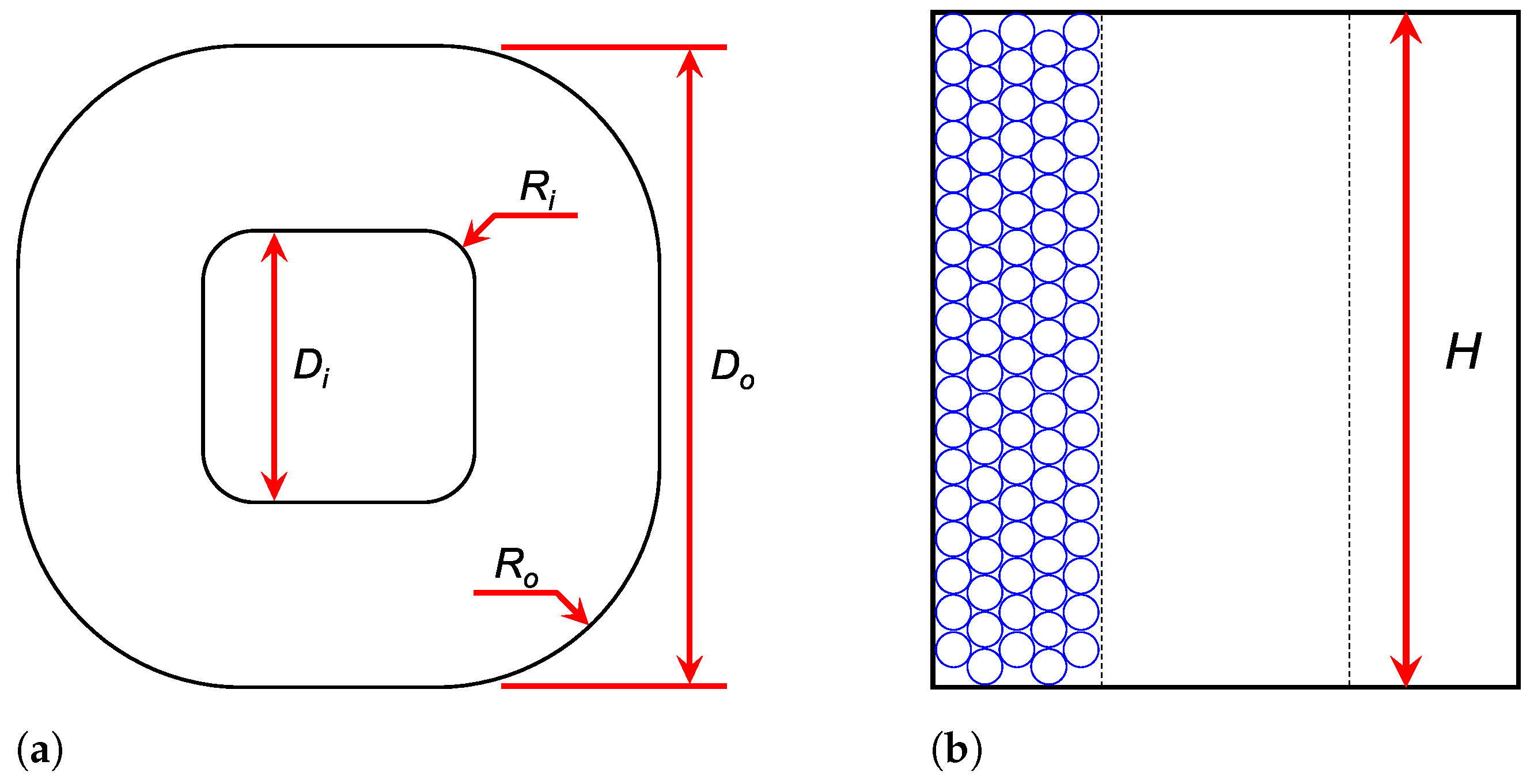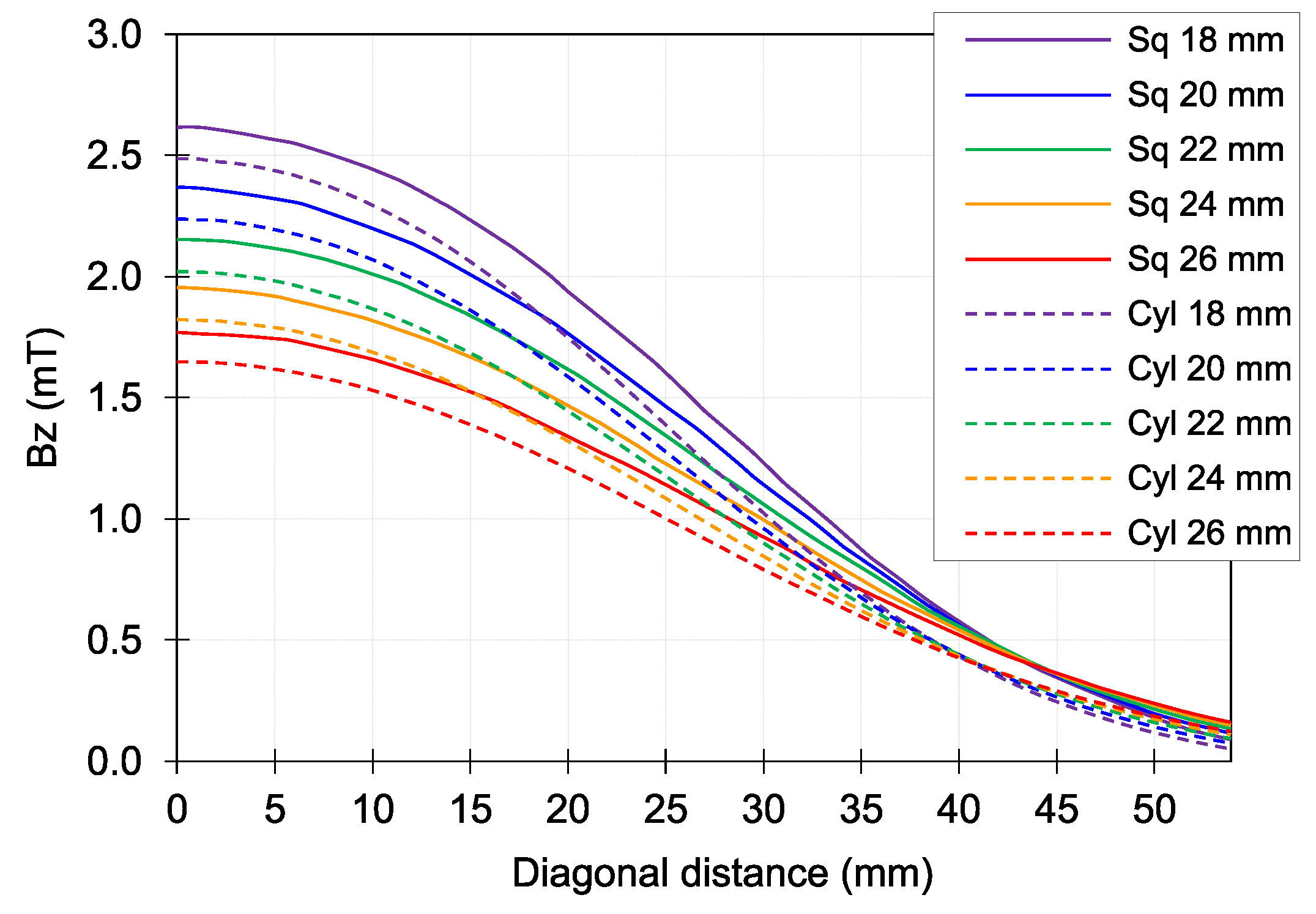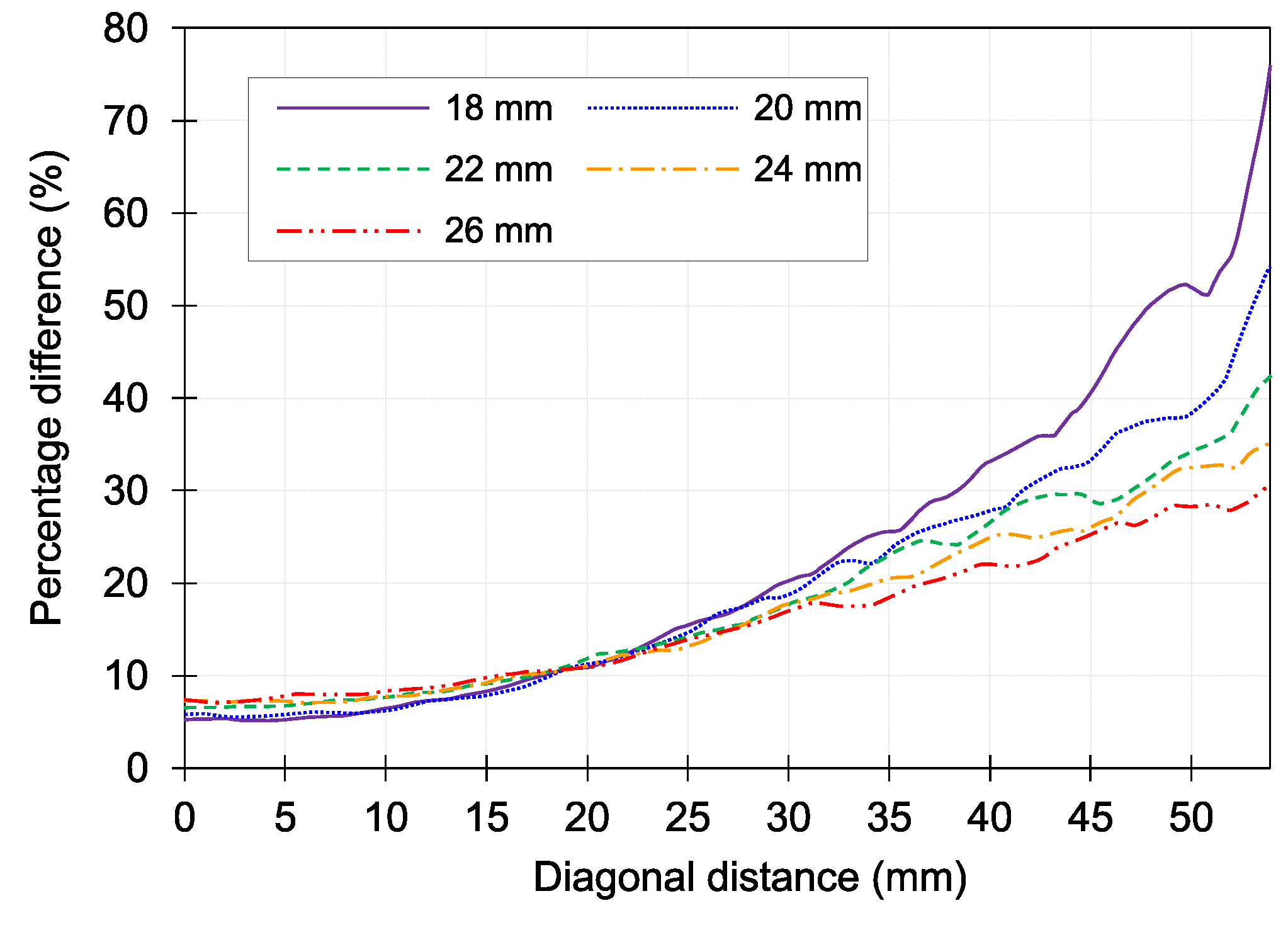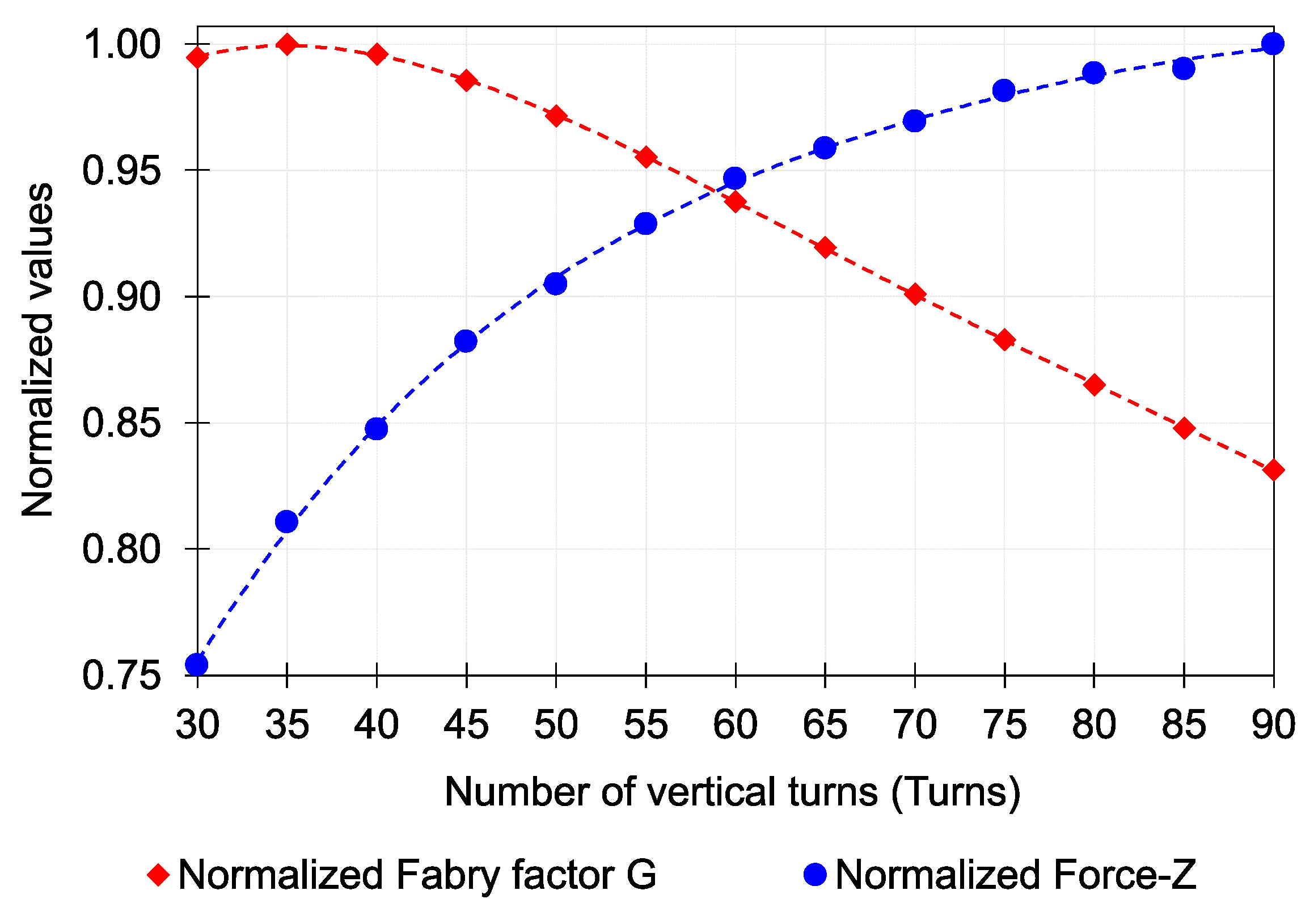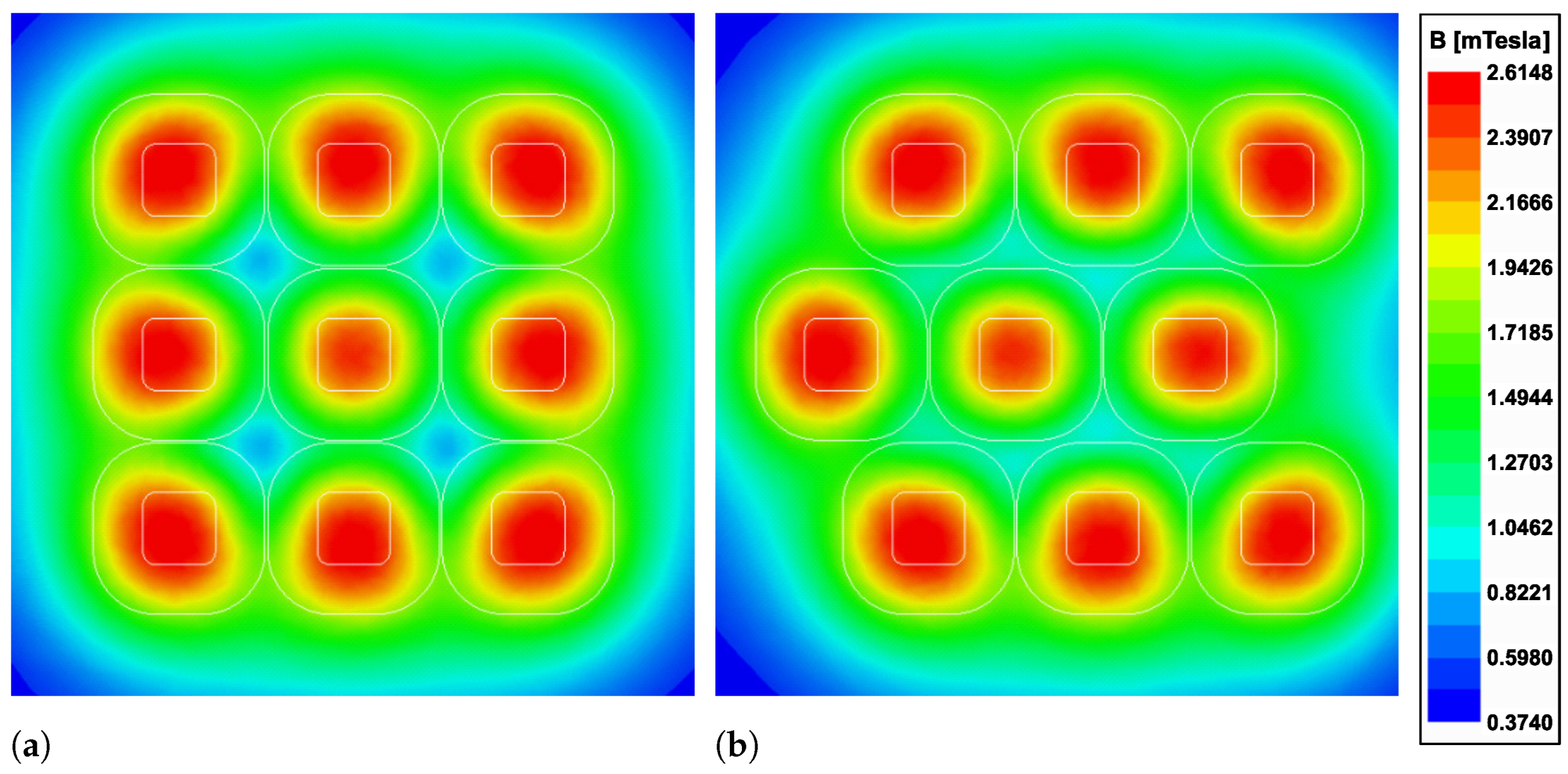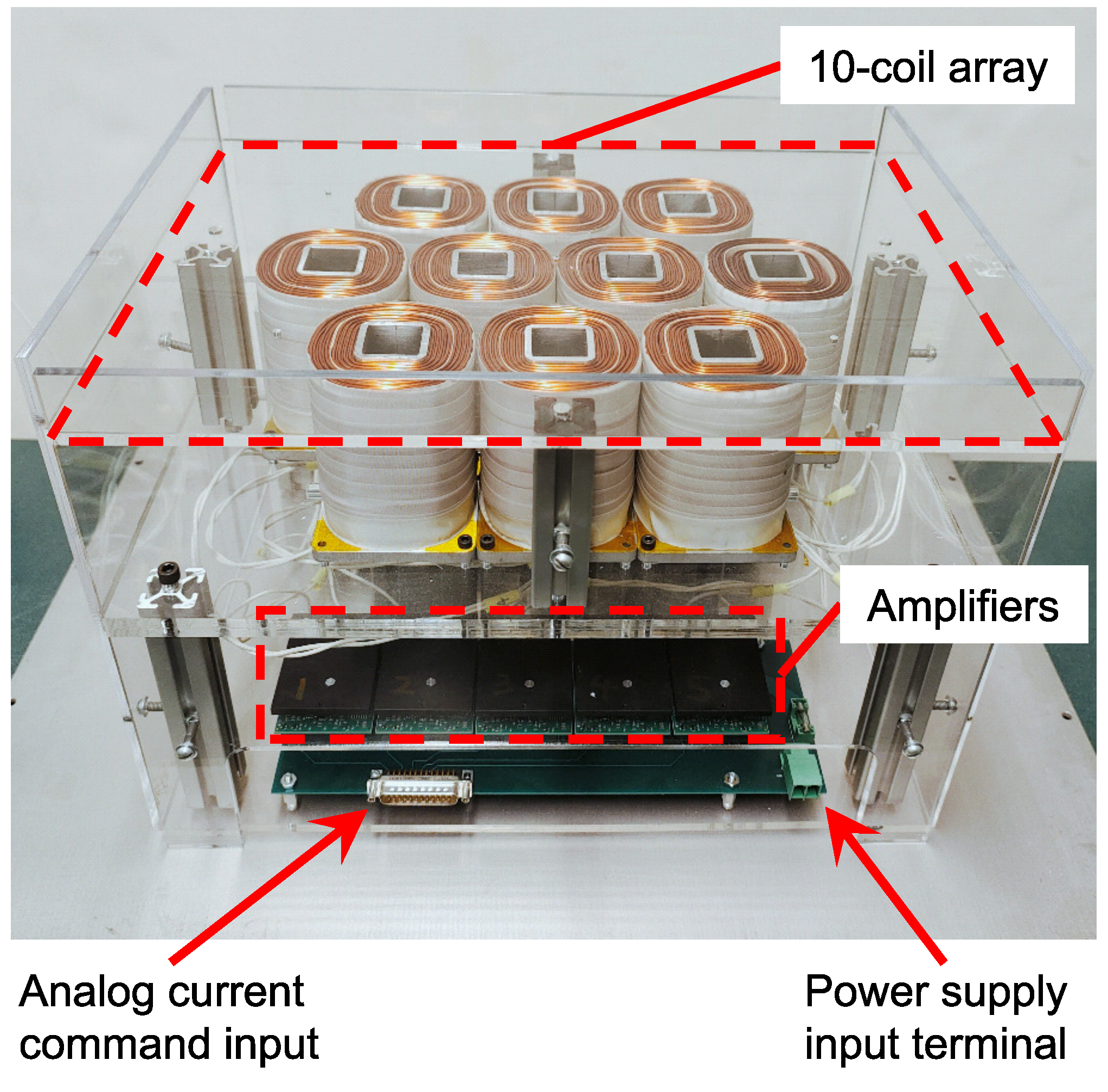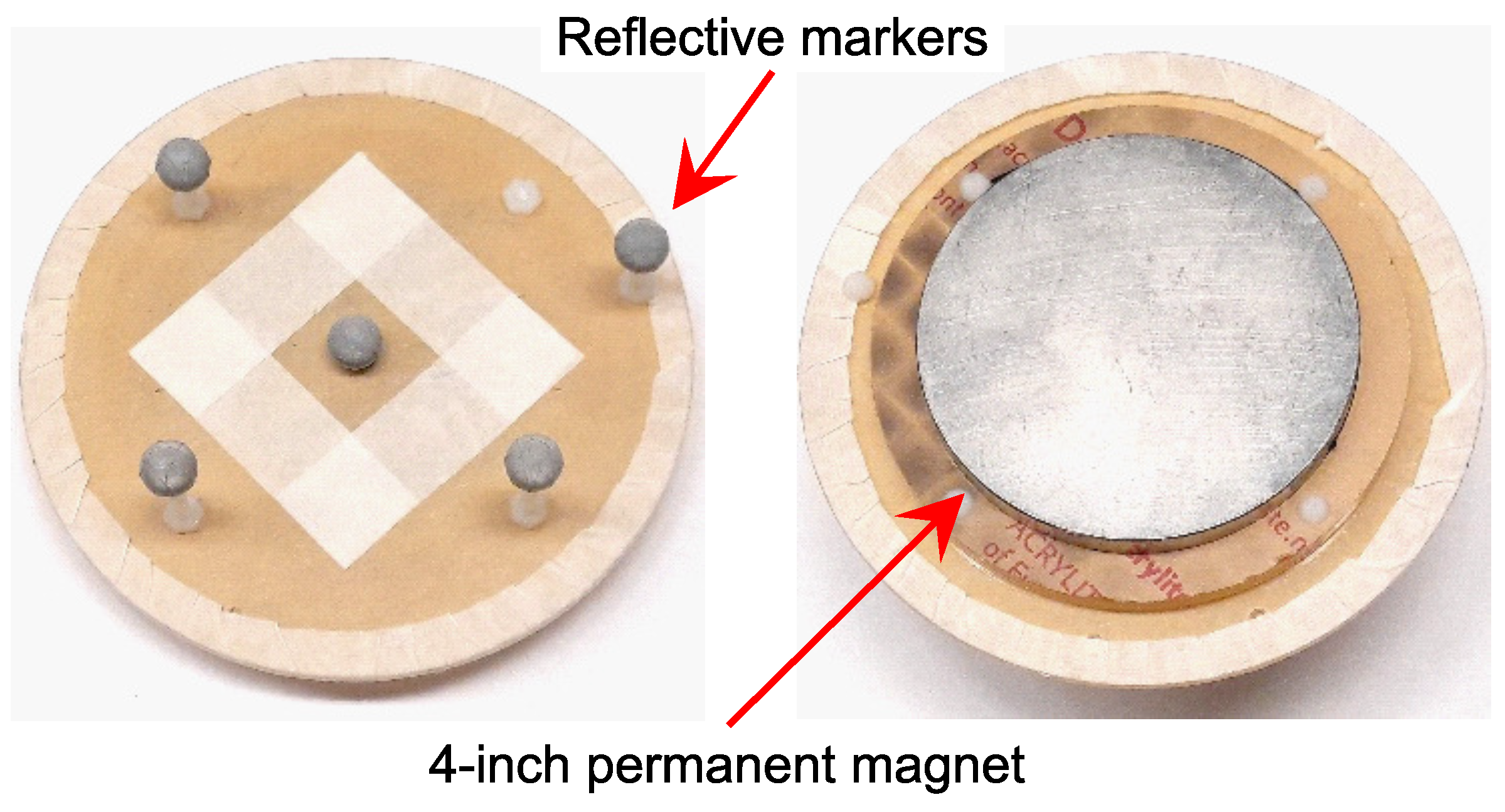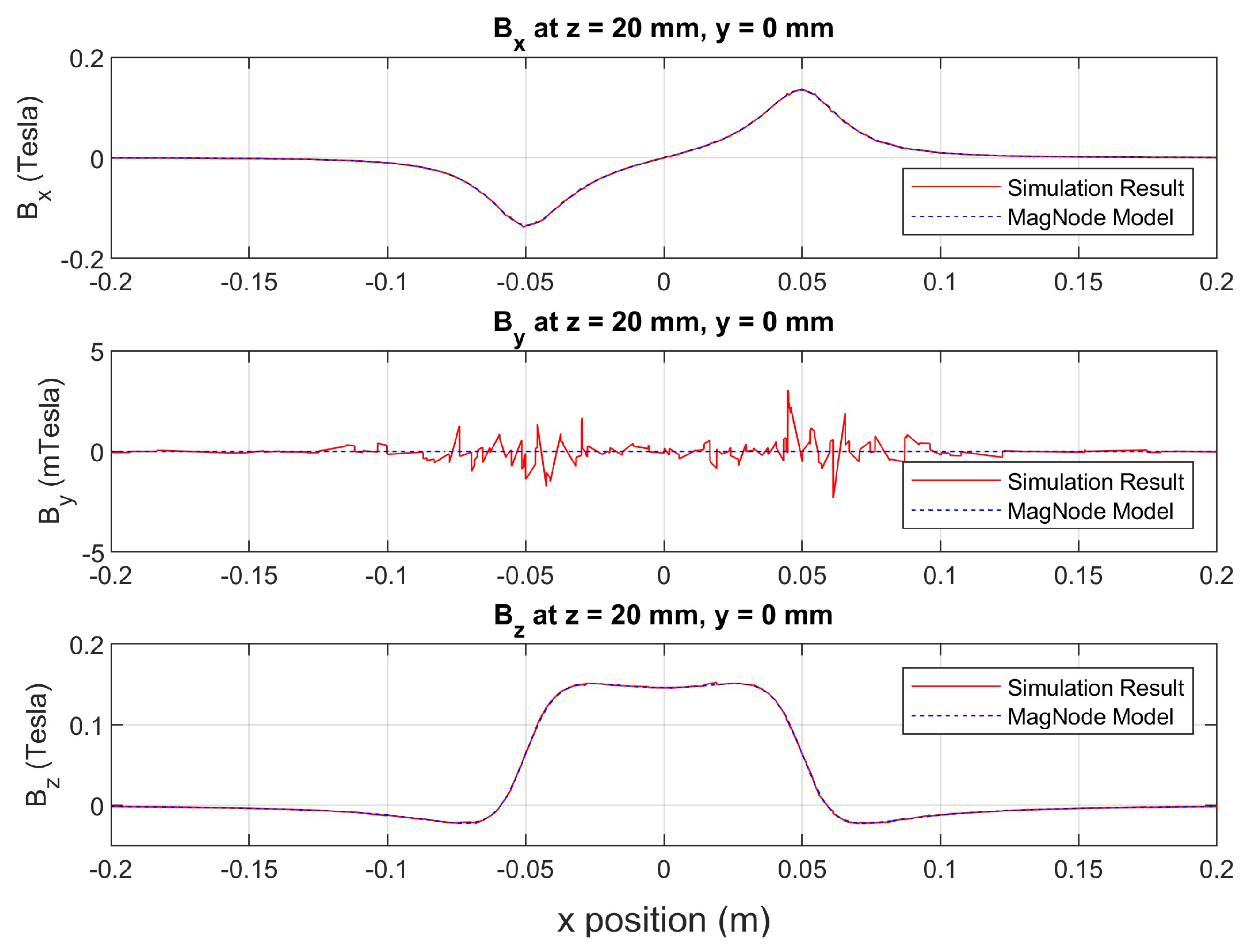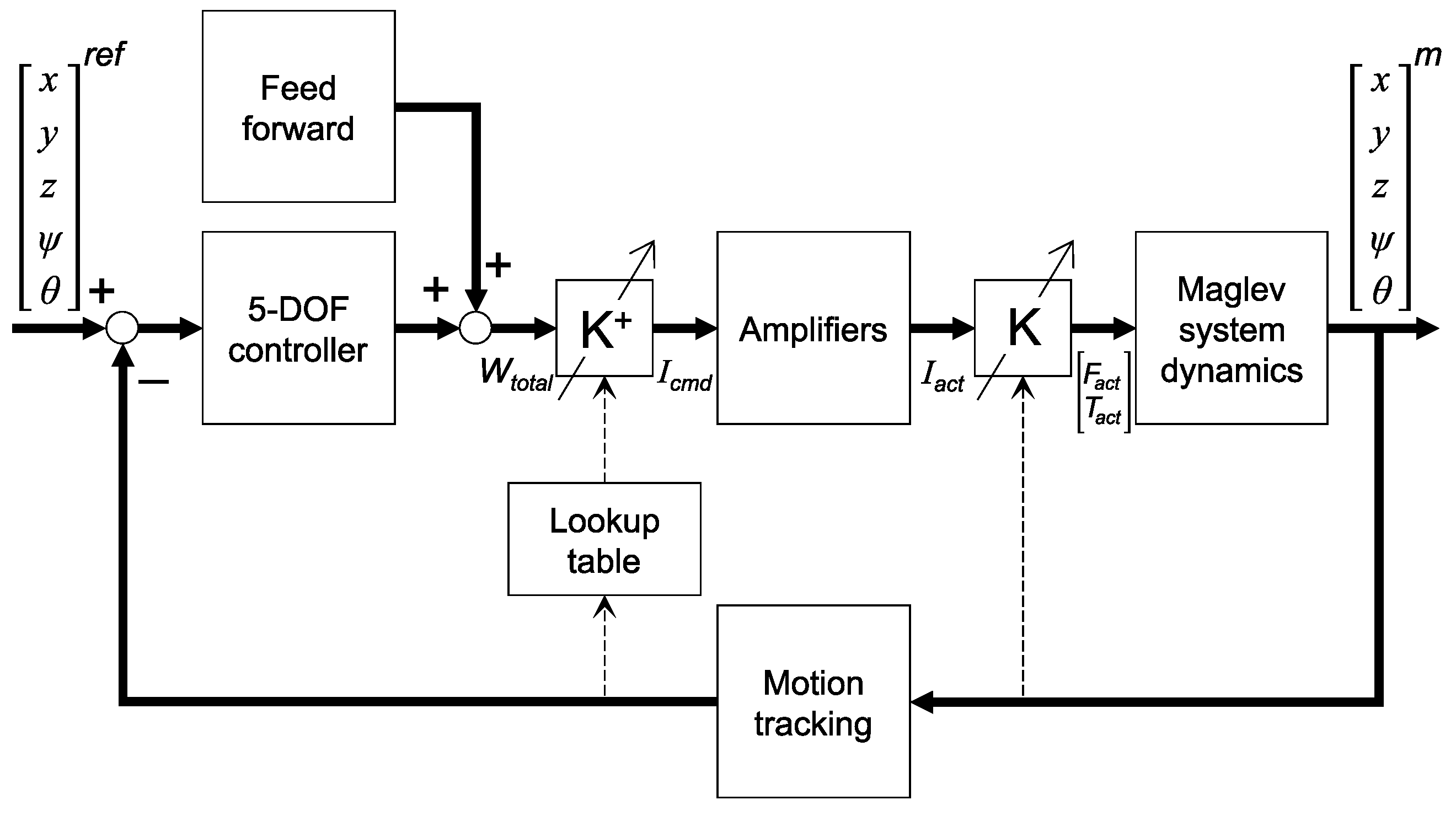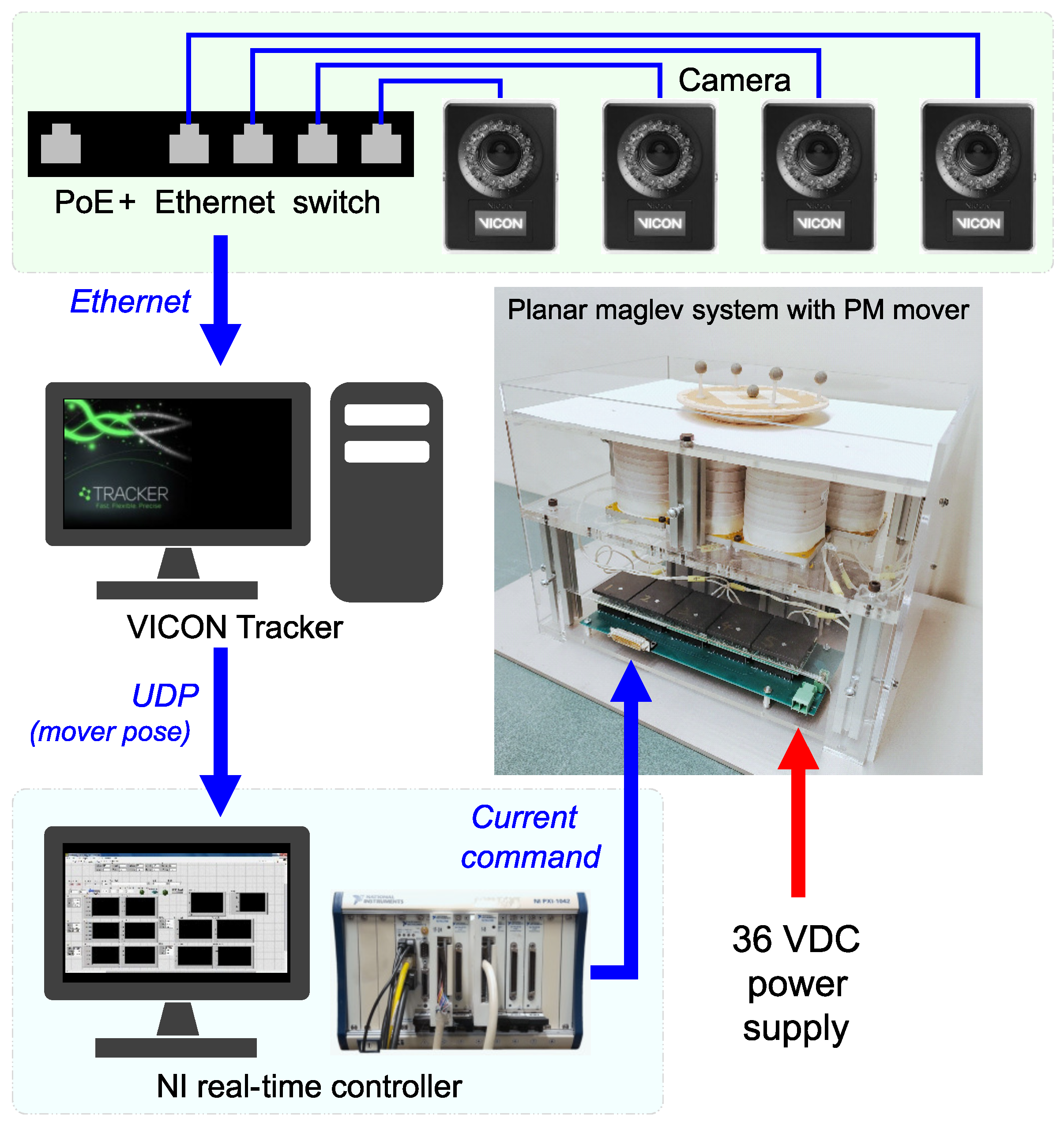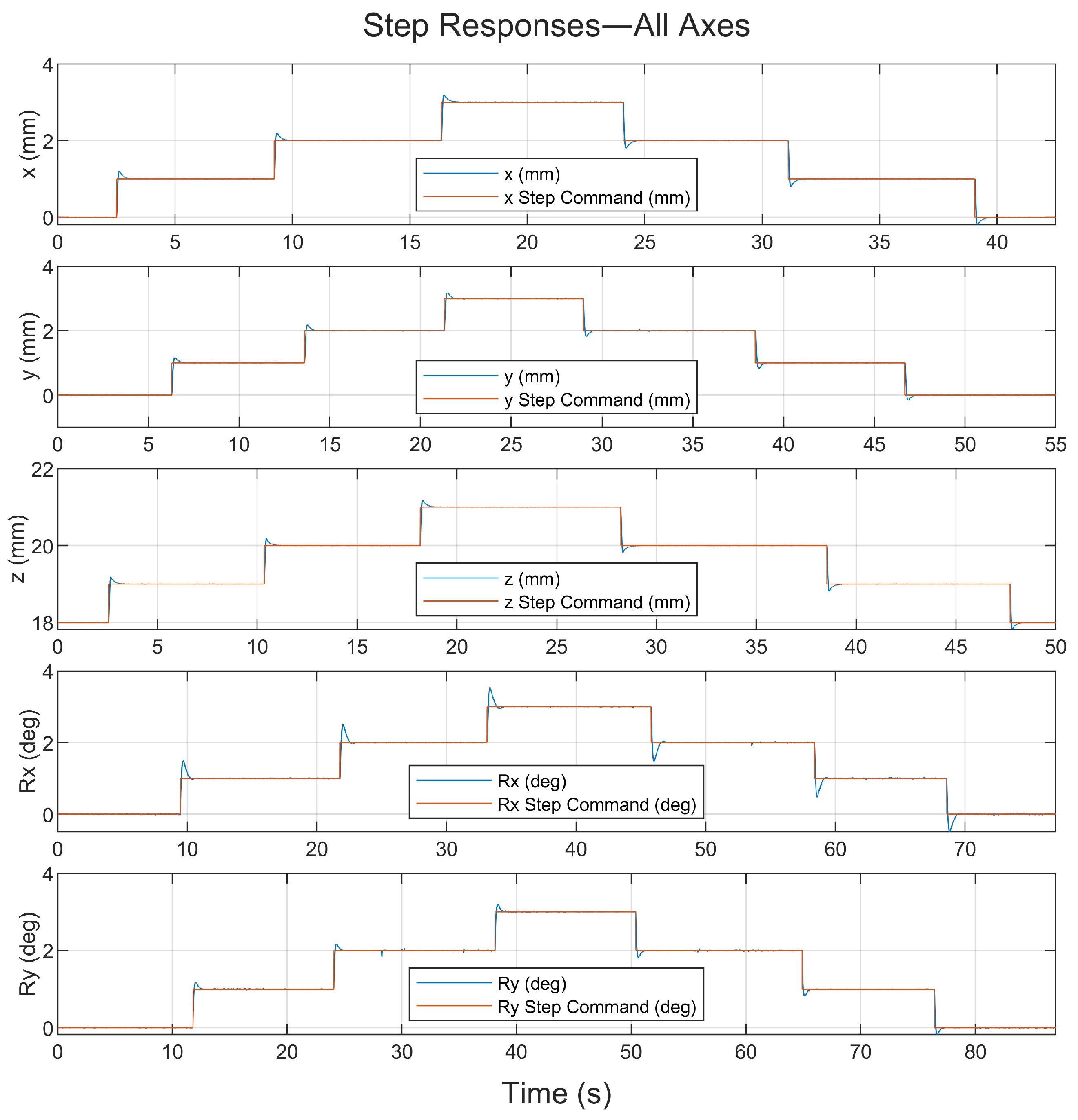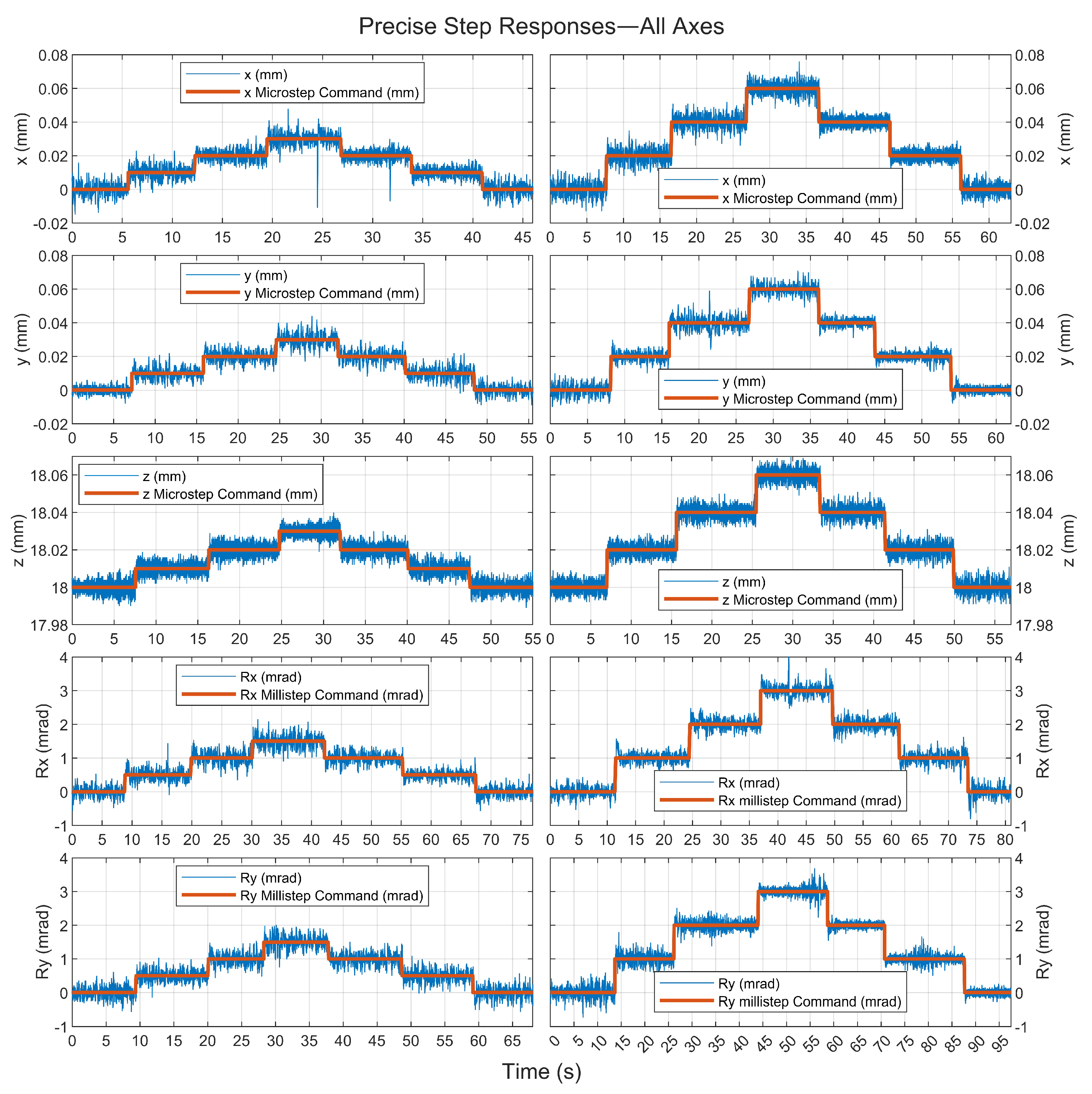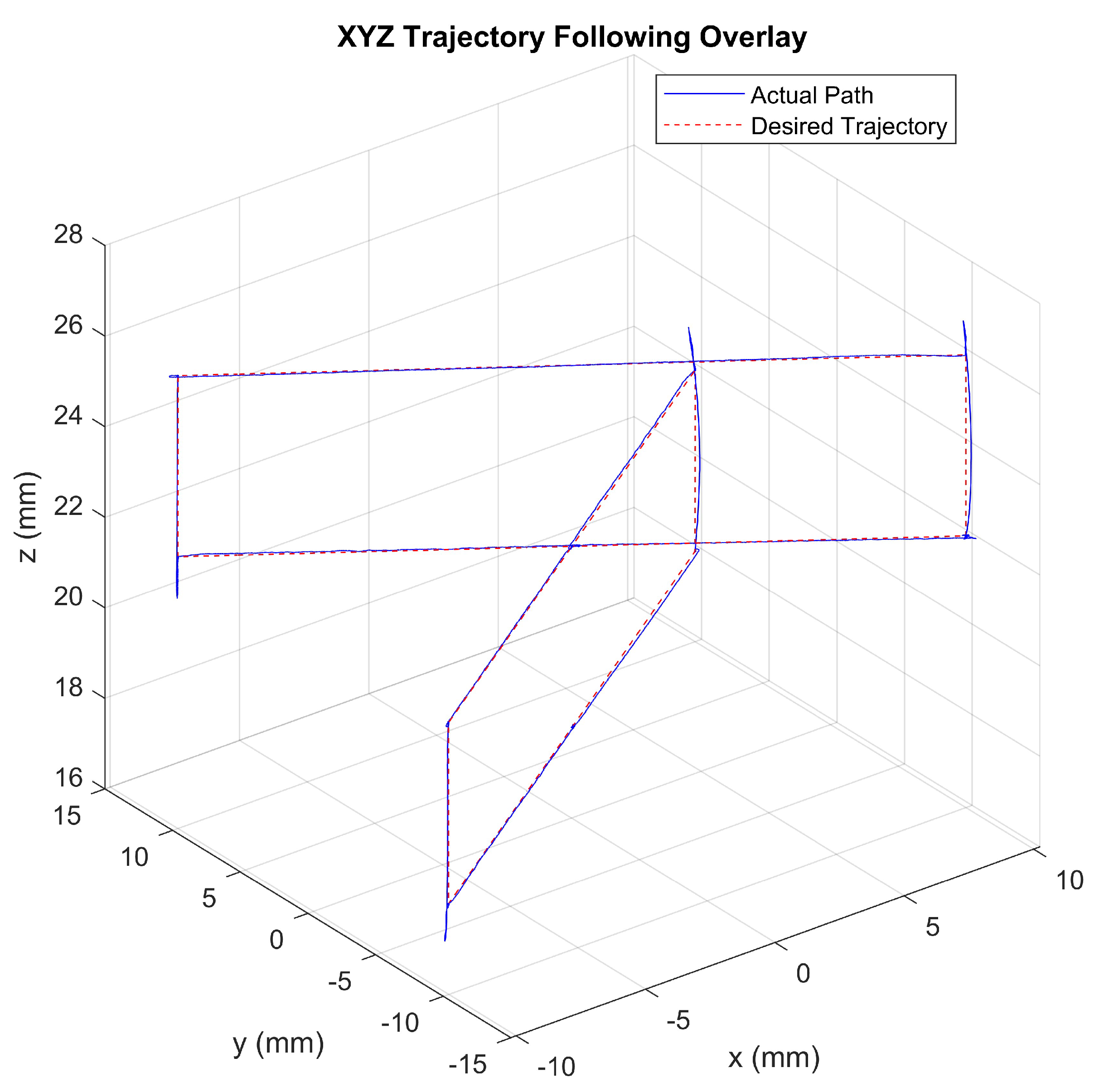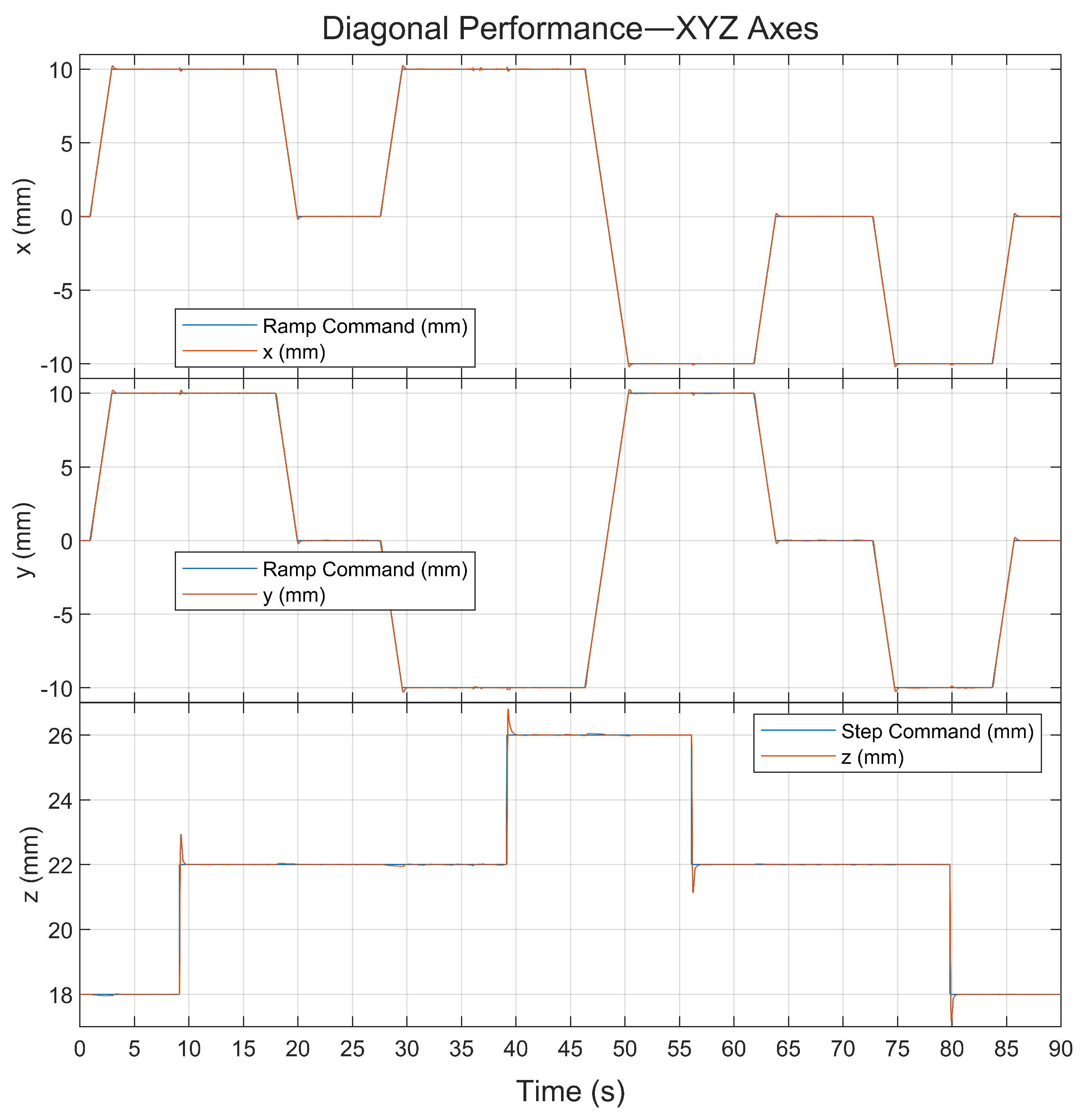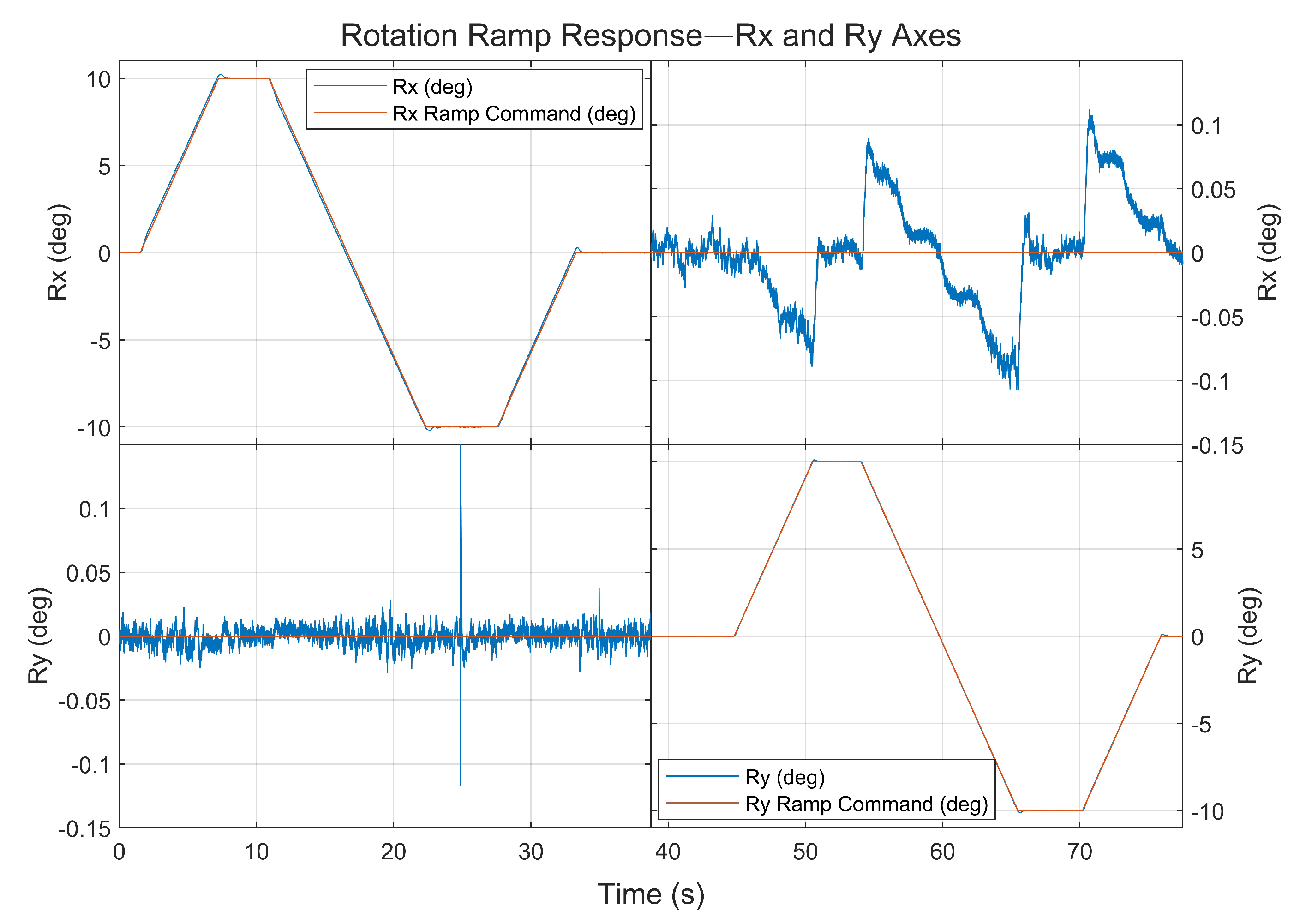1. Introduction
Nowadays, magnetic levitation or maglev technology is applied in various fields from macro- to microlevel applications. Maglev technology utilizes the interaction between magnets and/or electromagnets to levitate a magnetized object without contact. By manipulating the actuator outputs, attractive or repulsive forces are generated on the object to control the motion. With its advantages of low friction and contactless motion, maglev can provide high-speed and dustless motion. One of the well-known applications is high-speed transportation such as maglev trains [
1] and hyperloop [
2]. Meanwhile, various robotic applications using maglev technology can be found in [
3]. The maglev system can perform delicate tasks in micromanipulation [
4,
5,
6] and haptics [
7]. Moreover, it can also be applied for modern industrial applications, for example, metal melting [
8], magnetic bearing [
9] for high-speed electrical machines, and metal additive manufacturing [
10].
Another industrial application of maglev is for manufacturing systems. Since the suspended object can be controlled for multiple degree-of-freedom (DOF) motion, the maglev system can improve the flexibility of the machining or material handling tasks in the production line. For these tasks, the repulsive-type planar maglev system, which has the mover levitated on top of the stator, is more suitable than the attractive-type system because it enables the system to work with other automation systems such as CNC machines and industrial robots. For the planar maglev system structure, there are two types of movers, namely, moving coils and moving magnets, which work with magnet stators and electromagnet stators, respectively. Even though some research works use moving coil mover [
11,
12]; this type of mover is not popular because it must be equipped with or wired to the power source to energize moving coils.
By using several combinations of magnet movers and electromagnet stators, the previous research works mainly aimed to develop maglev systems for high-precision and/or long-range motion. For high-precision motion, the system structures are usually designed with multiple sets of coil stators and moving magnet arrays. The mover is controlled to have a fine motion with micro- or nanolevel precision and relatively small errors. An early high-precision maglev stage was developed for photolithography [
13] which had a translation range of 50 mm by 50 mm with a motion step size of 50 nm. Subsequent designs of high-precision maglev stages utilized multiple sets of 1-D Halbach arrays with long rectangular coils [
14] with 100 mm motion stroke and 20 nm step motion, or square coil arrays [
15] which presented the high-precision steps of 1
m and its RMSE of 0.58
m. The alternative stage design had multiple single-axis maglev actuators made of a cylindrical magnet and a cylindrical coil for vertical and horizontal motion control [
16]. The design of a dual-stage mover for fine motion can be found in [
17]. Not only precision linear stages, but the design of a circular Halbach array mover and electromagnet stator arranged in a circle can also achieve high-precision rotary table [
18,
19]. From the review, the Halbach array mover is widely used because it has the advantage of focusing a strong magnetic field on one side. Most of the proposed systems were invented for short- or medium-stroke motion with a small levitation gap below 10 mm and small rotation ranges. Moreover, most of the structures were designed as multiactuator stages. It is difficult to extend this structure for long-range motion even though some works have long motion strokes.
For long-range motion, the stator is designed to be planar and expandable since the motion range of the mover is limited by the stator area. A topology comparison of four coil arrays in [
20] indicated that the rectangular coil array in a herringbone pattern provided low-power dissipation and small force/torque ripples on the 2-D Halbach array mover. The modular stator of multilayer copper conductors in [
21] could be expanded easily while achieving precision motion with microlevel motion error. However, the levitation gap was still small. The long-range translation with a large levitation gap can be realized using disc magnets and a cylindrical coil array. A single disc magnet can be controlled for five-DOF motion only [
22] because of its symmetry around the vertical axis. In [
23], a two-disc-magnet mover could achieve six-DOF motion with an air gap of 25 mm. Then, the unlimited yaw rotation using six disc magnets mounted on a ball-shaped mover was demonstrated in [
24]. Nevertheless, the levitation error was large due to the slow sensing and control frequency.
In real-time motion control of the planar maglev system, the cross-coupling effect in this overactuated system is usually decoupled by a wrench–current transformation matrix. The force and torque components in this matrix are based on the Lorentz force law which requires the computations of (1) magnetic flux density and (2) forces and torques from the volume integral. For the magnetic flux density, the magnetic node approach [
25] is used for the rectangular magnet but is also applicable for the cylindrical magnet. The magnetic flux density of the Halbach array can be rapidly estimated by the order-reduction harmonic model [
26,
27]. Next, the volume integral can be solved by numerical methods. The Gaussian quadrature technique which can transform the integral into the summation was implemented on an FPGA for parallel computing [
28] and used for real-time decoupling for the maglev rotary table in [
29].
Alternatively, selecting the nearest wrench–current transformation matrix from a lookup table, which stores precomputed transformation matrices in a specific range, was used for disc-magnet mover in [
22,
30]. However, the lookup table approach has a problem with its discrete data. The effectiveness of decoupling at the no-data locations deteriorates because the transformation matrix is acquired from the nearest data. Therefore, the decoupling enhancement using estimation techniques for the transformation matrix at the locations without lookup data can improve the levitation performance. The multidimensional linear interpolation was implemented in [
23,
24] to improve the accuracy in long-range translation and rotation whereas the performance of the fine motion was not examined. This paper presents a novel design of a compact planar maglev system, which is capable of expanding for large-area omnidirectional levitation while performing a high-precision motion, to be applicable to modern manufacturing systems. The main objectives of this work are described as follows:
The compact and portable design of a five-DOF repulsive planar maglev prototype using an array of square coils with a single disc magnet mover: The system is intended to perform as a fine motion stage for a precision machining workstation. Meanwhile, the design is capable of expanding the planar stator as a module for long-range levitation.
Wrench–current decoupling enhancement using multidimensional interpolation for the fine motion: An implementation of a linear interpolation method can improve the levitation performance at the mover pose without data in the lookup table. This method is feasible to deploy on a control system with limited computational resources.
The rest of this paper is organized as follows:
Section 2 details the compact planar maglev system design. The implementation of the working principle from
Section 3 and the wrench–current decoupling enhancement using a linear multidimensional interpolation for the real-time control system are described in
Section 4. The results of levitation experiments are presented in
Section 5. The discussions of this work are given in
Section 6 and a conclusion is provided in
Section 7.
4. Control System
After obtaining the Lorentz force and torque models, this section provides the details of the real-time implementation of the 5-DOF controller.
4.1. Control Algorithm
An overall 5-DOF control diagram is illustrated in
Figure 10. By using the wrench–current transformation, the cross-coupling effect could be decoupled and a 5-DOF PID controller was applied to control each degree of freedom separately. The precomputed wrench–current transformation matrices were stored in the lookup table. The transformation matrix could be looked up by using the moving pose obtained from the motion tracking system. Additional feed-forward control was used to compensate for the mover weight in a vertical motion.
The tuned PID parameters for the proposed system are shown in
Table 5. It is worth noting that the PID parameters were different on the
x and
y axes. Similarly, the parameters were different on the
and
axes. Due to the zigzag configuration of the ten-coil array as shown in
Figure 8, the different arrangements of the coils along the
x and
y axes featured the maglev system controller with different PID parameters along the
x and
y axes. Therefore, the tuned parameters were different on the axes. The units of the PID gains were selected as SI units. For rotations, due to the difficulty of the system to generate large torques, the gains were relatively small quantities with SI units.
4.2. Decoupling Method Using Wrench–Current Transformation Matrix
The proposed ten-coil planar maglev system was a MIMO overactuated system with ten coil current inputs and 5-DOF motion outputs. The yaw rotation around the
z axis could not be controlled because of the axial symmetry of the disc magnet. Therefore, the torque about the
z axis was not considered in the control design. From the Lorentz force law in the previous section, the forces and torques were proportional to the coil currents
. Therefore, the force and torque equations as a function of coil currents could be written as
where
is the commutation matrix. It represents the relationship between the coils and the forces and torques on the magnet at specific pose
when each coil is supplied with a 1 A current.
In the control system, the total wrench (forces and torques) command
from the 5-DOF PID controller and feed-forward controller was decoupled and transformed to coil current command
by
where the wrench–current transformation matrix or wrench matrix
is an inverse of the commutation matrix. Since the commutation matrix is usually a nonsquare matrix, the Moore–Penrose pseudoinverse can be computed instead, expressed by
Next, the implementation of the wrench–current transformation matrix for decoupling using the lookup table is presented.
4.3. Lookup Table
Since the wrench–current transformation matrix is a function of the mover pose, the real-time solution of this matrix must be computed for every control sampling. However, numerically computing the Lorentz forces and torque cannot be implemented in real time. Hence, in this work, the wrench–current transformation matrices within a specific range of motion were precomputed and stored in a lookup table.
To keep the size of the lookup table reasonable while providing sufficient information for the operational space, a 5-D table with a 1 mm grid on both x and y axes from −10 mm to 10 mm, 1 mm grid on z axis from 18 mm to 26 mm, and a 5-degree grid on both and axes from −10 degrees to 10 degrees was created. The matrix with corresponding mover pose closest to the current mover pose was returned while searching the lookup table at runtime. This lookup table approach helped reduce the computation cost by sacrificing the controller memory. Only a finite number of mover poses were stored. Therefore, it was inevitable to use lookup results when the operation location was not in the lookup data. By applying a multidimensional linear interpolation approach, the transformation matrix could be estimated for the desired pose instead of using the nearest data.
4.4. Multidimensional Linear Interpolation
The closest pose search of the lookup table was utilized at runtime to find the current outputs. Therefore, inconsistent errors were expected when switching selected matrices, which degraded the overall controller performance. To improve the real-time control performance, a multidimensional linear interpolation method was introduced to smooth out the errors brought by data switching.
The interpolation could be formulated as follows. The
,
,
,
, and
were used to represent the weighting parameters for the multidimensional linear interpolation of the
x,
y,
z,
, and
states of the mover pose, respectively. Suppose that the random 5-DOF pose to be interpolated was at (
,
,
,
,
), which was between the state pairs,
,
,
,
,
,
,
,
, and
,
, respectively. The weighting parameters could be calculated by
where
p can be the
x,
y,
z,
, or
state. This formula could be generalized for extrapolation purposes. Once the weighting parameters were obtained, the general results of the interpolated wrench matrix could be found for any desired states as expressed in
For
n-dimension or -state interpolation, a total of
number of wrench matrices were needed. Then, we applied Equation (
11) as explained in Algorithm 1 to find
. In the 5-D case, there were 32 wrench matrices to extract. Due to controller constraints, only a 2-D linear interpolation was implemented with two combinations of
x–
y and
–
axes separately.
| Algorithm 1 Multidimensional linear interpolation |
| Require: A precomputed lookup table |
| Input: The sensor mover pose readings , , , , and , only work with the states needed |
| Output: The interpolated results |
| Initialization zeros(5, 10), n as the number of states selected |
| Calculate the weights and |
| whiledo {n while loops to be precise} |
|
lookup |
| find the product |
| |
| |
| end while |
6. Discussion
This section provides a discussion of the proposed compact planar maglev system design and levitation experiment results.
6.1. Compact Planar Maglev Design
The proposed compact maglev system had a planar square coil array to achieve both fine and long-range motion controls. The round-corner square coil was initially designed by the Fabry factor as it resembled the cylindrical coil. With the magnetic flux density comparison, the coil height was thereby optimized to achieve a high levitation force with acceptable power efficiency. Even though the zigzag array was better, the straight array might be more suitable to build as a compact module for an expanded work area. The design of the magnet mover will be important for efficiency in levitation.
For the development of an expandable planar maglev system, two main components must be considered: system communication and motion-tracking system. The analog signal command in this work might not be suitable for a large area. The control and current driver components with automation protocols will provide more robust communication. The vision system is flexible for scalable areas. However, the larger the tracking area, the worse the motion-tracking quality.
6.2. Levitation Experiment Results
The experiment results demonstrated both precision motion and long-range motion. The 2-D linear interpolation could enhance the wrench–current transformation. The effectiveness of the interpolation was tested by moving the mover to the location with no data available in the lookup table. For high-precision motion, the mover was controlled to move with steps of 10 and 20 m for translation and 0.5 and 1 mrad for roll and pitch. The precision of the system was limited by the motion sensor.
To prove the concept of long-range motion, the mover was moved within the horizontal area of 20 mm × 20 mm with a vertical motion range from 18 mm to 26 mm. The rotation range was ±10 degrees for both roll and pitch. A large overshoot could be observed in large-step motion. Even though the multidimensional linear interpolation could improve the levitation as discussed, the real-time solution to decouple the wrench command was still important.
From the experiment results, there were two main problems that significantly deteriorated the levitation performance: undesired yaw motion and system lag. In the experiments, the untethered mover was suspended in the air with five controllable degrees of freedom. Imperfect control efforts could result in an undesired yaw motion, especially, during the large motion. Unwanted rotation could cause oscillations in other axes.
Next, the authors believe that the reason for the large spikes in both precision and long-range motion might be the limitation of the old controller hardware. Prior to the experiment, large spikes occurred frequently when too many features were implemented. Therefore, the linear interpolation was limited to 2-D with a ramp command feature to reduce the computational load in this work.
By comparing with other previous works, the proposed planar maglev prototype had several advantages and room for improvement. First, for the range of motion, the system could move with a long range, especially in the vertical direction with a 26 mm levitation gap, compared to other works with the disc magnet [
22] and Halbach array [
21]. A solution for unlimited translation is needed since the horizontal range was relatively small and yaw motion was not controlled. Next, the fine-step motion of 10 and 20
m demonstrated an improvement of this system compared to other works with disc magnets [
23,
30]. The precision motion quality can still be improved for better performance such as that of the Halbach array [
17].
From the discussions above, there are plenty of research opportunities for the design and levitation performance of the proposed planar maglev system. For educational purposes, a cost-effective planar maglev system using inexpensive sensors and a controller can be built as found in [
33]. For precision motion, with the most recent review in [
34], the challenges lie in solutions for effective fine-level sensing, long-range extension, and extreme performance such as high-speed motion. In high-speed motion or long-time use, the coils must consume a lot of currents and heat up quickly. The generated heat will affect levitation performance. The analysis of the thermal model [
35] and the design of the cooling system are important. The eddy current damping, produced by array cover materials such as aluminum, could improve the stability even though it affects the speed. However, the selected material must be optimized to avoid an excessive damping force on the mover [
36]. Lastly, advanced control can be applied for complicated tasks, for example, iterative control for higher precision in repetitive motion [
19,
37], or a study on transient responses with external disturbances and the design of a robust controller to improve levitation performance in real-world applications.
